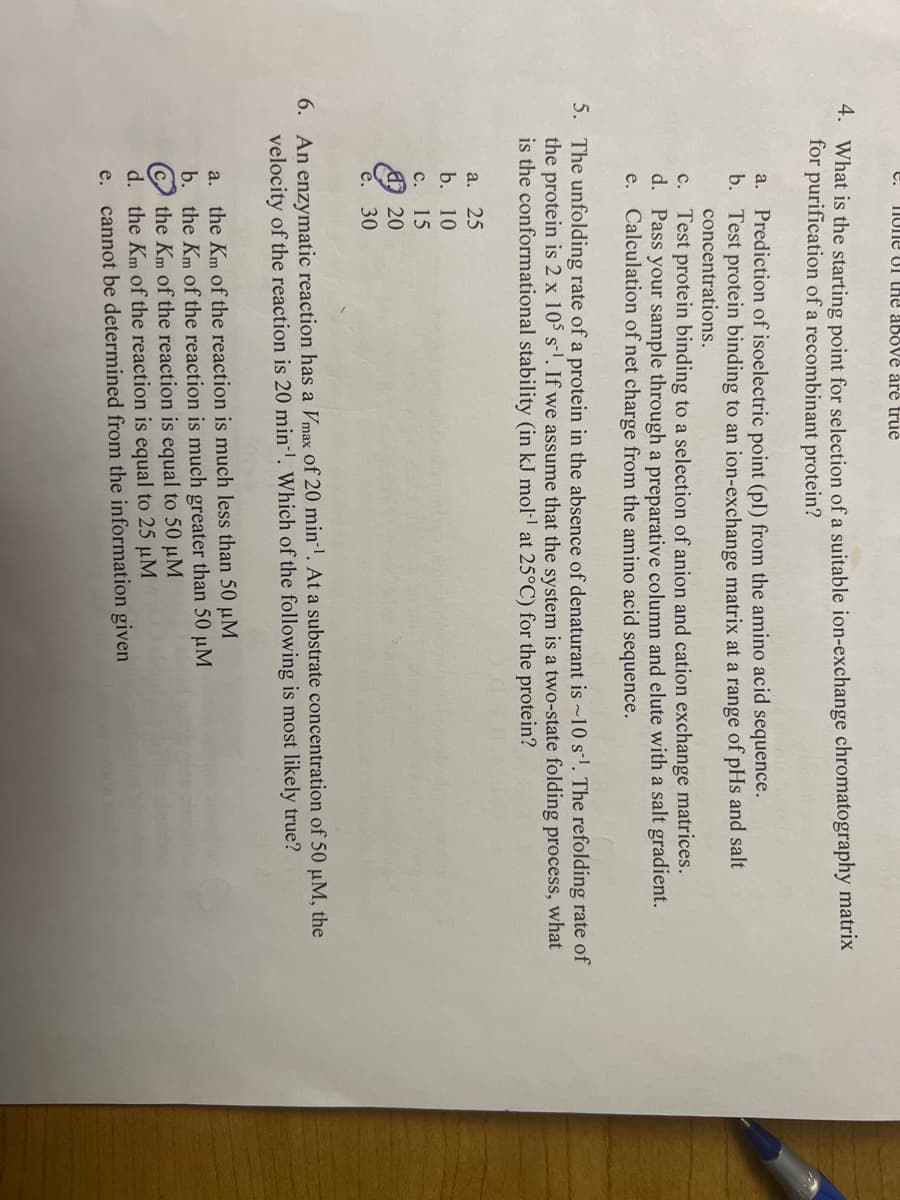IIUne UI the above äre true 4. What is the starting point for selection of a suitable ion-exchange chrom for purification of a recombinant protein? a. Prediction of isoelectric point (pl) from the amino acid sequence b. Test protein binding to an ion-exchange matrix at a range of pH: concentrations. c. Test protein binding to a selection of anion and cation exchange d. Pass your sample through a preparative column and elute with a e. Calculation of net charge from the amino acid sequence. 5. The unfolding rate of a protein in the absence of denaturant is ~10 s-l. T the protein is 2 x 10° s-'. If we assume that the system is a two-state fold is the conformational stability (in kJ mol- at 25°C) for the protein? а. 25 b. 10 с. 15 20 е. 30 6. An enzymatic reaction has a Vmax of 20 min'. At a substrate concentrati velocity of the reaction is 20 min-. Which of the following is most like a. the Km of the reaction is much less than 50 µM b. the Km of the reaction is much greater than 50 µM the Km of the reaction is equal to 50 µM d. the Km of the reaction is equal to 25 µM e. cannot be determined from the information given е.
IIUne UI the above äre true 4. What is the starting point for selection of a suitable ion-exchange chrom for purification of a recombinant protein? a. Prediction of isoelectric point (pl) from the amino acid sequence b. Test protein binding to an ion-exchange matrix at a range of pH: concentrations. c. Test protein binding to a selection of anion and cation exchange d. Pass your sample through a preparative column and elute with a e. Calculation of net charge from the amino acid sequence. 5. The unfolding rate of a protein in the absence of denaturant is ~10 s-l. T the protein is 2 x 10° s-'. If we assume that the system is a two-state fold is the conformational stability (in kJ mol- at 25°C) for the protein? а. 25 b. 10 с. 15 20 е. 30 6. An enzymatic reaction has a Vmax of 20 min'. At a substrate concentrati velocity of the reaction is 20 min-. Which of the following is most like a. the Km of the reaction is much less than 50 µM b. the Km of the reaction is much greater than 50 µM the Km of the reaction is equal to 50 µM d. the Km of the reaction is equal to 25 µM e. cannot be determined from the information given е.
Chapter24: Introduction To Spectrochemical Methods
Section: Chapter Questions
Problem 24.28QAP
Related questions
Question
Number 4 please

Transcribed Image Text:e.
IIUne UI tHe above åre true
4. What is the starting point for selection of a suitable ion-exchange chromatography matrix
for purification of a recombinant protein?
Prediction of isoelectric point (pl) from the amino acid sequence.
b. Test protein binding to an ion-exchange matrix at a range of pHs and salt
concentrations.
a.
c. Test protein binding to a selection of anion and cation exchange matrices.
d. Pass your sample through a preparative column and elute with a salt gradient.
e. Calculation of net charge from the amino acid sequence.
5. The unfolding rate of a protein in the absence of denaturant is ~10 s-l. The refolding rate of
the protein is 2 x 105 s-l. If we assume that the system is a two-state folding process, what
is the conformational stability (in kJ mol- at 25°C) for the protein?
а. 25
b. 10
с. 15
O 20
30
6. An enzymatic reaction has a Vmax of 20 min-. At a substrate concentration of 50 µM, the
velocity of the reaction is 20 min-'. Which of the following is most likely true?
a. the Km of the reaction is much less than 50 µM
b. the Km of the reaction is much greater than 50 µM
the Km of the reaction is equal to 50 µM
d. the Km of the reaction is equal to 25 µM
e. cannot be determined from the information given
Expert Solution
This question has been solved!
Explore an expertly crafted, step-by-step solution for a thorough understanding of key concepts.
Step by step
Solved in 2 steps

Knowledge Booster
Learn more about
Need a deep-dive on the concept behind this application? Look no further. Learn more about this topic, chemistry and related others by exploring similar questions and additional content below.Recommended textbooks for you


Principles of Instrumental Analysis
Chemistry
ISBN:
9781305577213
Author:
Douglas A. Skoog, F. James Holler, Stanley R. Crouch
Publisher:
Cengage Learning



Principles of Instrumental Analysis
Chemistry
ISBN:
9781305577213
Author:
Douglas A. Skoog, F. James Holler, Stanley R. Crouch
Publisher:
Cengage Learning
